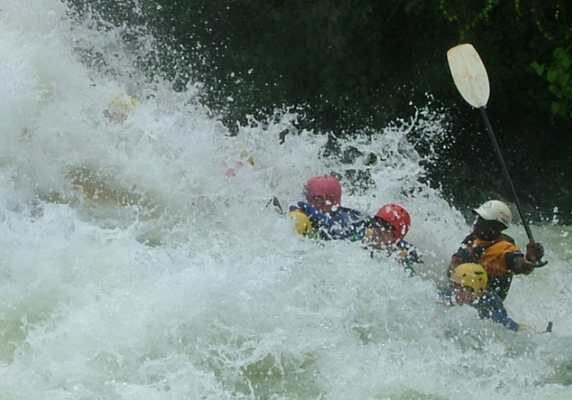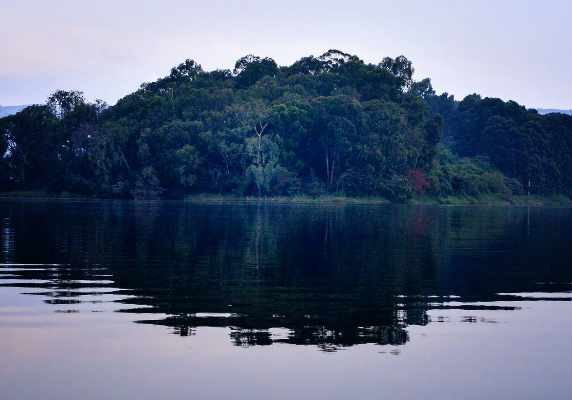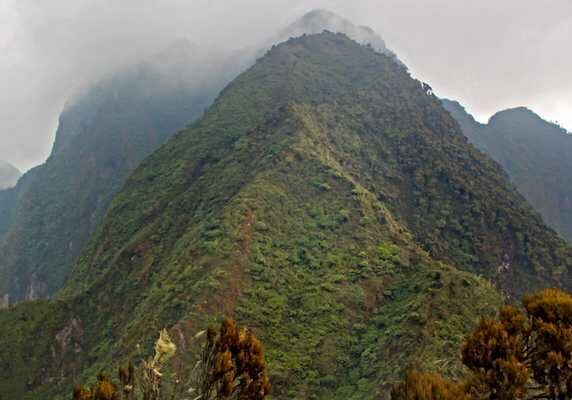
Gorilla Trek, Sabyinyo Volcano Hike and Canoeing- 5 Days
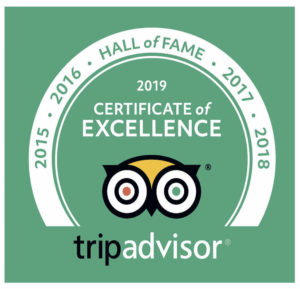 Adventurous Uganda Gorilla trek tour in a 5-day gorilla trek tour with a hike of Sabyinyo volcano/ Muhavura/ Gahinga/ Sabinyo Gorge in Mgahinga Gorilla National Park as well as canoeing along Lake Bunyonyi.
Adventurous Uganda Gorilla trek tour in a 5-day gorilla trek tour with a hike of Sabyinyo volcano/ Muhavura/ Gahinga/ Sabinyo Gorge in Mgahinga Gorilla National Park as well as canoeing along Lake Bunyonyi.
This 5-day gorilla trek tour, hike of Sabyinyo volcano/ Muhavura/ Gahinga/ Sabinyo Gorge in Mgahinga Gorilla National Park and Lake Bunyonyi canoeing is one of the best for gorilla tracking with adventure fun in Kisoro, Uganda.
The tour can start on any day with a minimum of 1 person. We start/end from Entebbe/Kampala in Uganda or Kigali in Rwanda.
Gorilla Trek, Sabyinyo Volcano Hike Canoeing - 5 Days
- Day 1: Drive to Bwindi impenetrable Forest from Entebbe or Kigali
- Day 2: Gorilla Trekking in Bwindi Impenetrable National Park
- Day 3: Hike Sabyinyo, Muhavura, Gahinga Volcano or Sabinyo Gorge in Mgahinga Gorilla National Park.
- Day 4: Canoeing along Lake Bunyonyi
- Day 5: Return to Entebbe or Kigali
Day 1: Meet in Entebbe, drive to Bwindi impenetrable Forest (we can also pick from Kigali on request)
Meet and greet with our local guide over breakfast, and then after drive heading to southwestern Uganda.
En route, there is a local community popular for making local drums and crafts and a fruit market. Stopover, admire and buy yourself souvenirs. Proceed to the Equator line taken as one beautiful scenery in Africa - the pathway of the sun and take photographs.
Pass by mountains, tropical rainforest and bamboo forest during the ±8 hours journey.
Accommodation options available (all on full board basis)
Up-market: Chameleon Hill Lodge | Nkuringo Gorilla Lodge Bwindi
Moderate: Ichumbi Gorilla Lodge| Engagi Lodge
Low Budget: Gorilla Haven Lodge Rushaga
Meals included today: Lunch and dinner only.
Day 2: Gorilla Trekking in Bwindi Impenetrable National Park
Today enjoy gorilla trekking in Bwindi.
After breakfast, proceed for the morning briefing before enjoying the highlight of the trip - gorilla trekking, which may last the entire day.
We trek the gorillas through the rainforest and bamboo covered slopes, accompanied by a guide and trackers, in search of a mountain gorilla family. The walking can sometimes be tough and long, but when you catch a glimpse of the magnificent silverback, any discomforts will be quickly forgotten. When the gorillas are sighted, visitors will be guided to within 6 metres from the gorillas, sit around them for a whole hour while gazing into their big round eyes.
Gorilla trekking is unpredictable. It's difficult to foresee how many hours you will hike. The gorilla excursion can take from 2 up to 8 hours. Expect to walk a long distance in steep and muddy conditions, sometimes with rain overhead, before you encounter any gorillas. A good physical condition is recommended. For conservation purposes, time spent with the gorillas is limited to one hour. A ranger will brief you on how to behave with the gorillas.
While most of today's forests are no more than 12,000 years old, Bwindi's vegetation has been weaving itself into tangles over at least 25,000 years, in the process accumulating a lengthy species list. This includes 310 species of butterfly, 51 reptiles, 200 trees, 88 moths and an exceptional 120 types of mammal including 10 primates. The latter includes chimpanzee, L'Hoest's, red-tailed and blue monkey, black and white colobus, baboon, and Bwindi's most famous resident, the mountain gorilla.
Bwindi is a prime destination for birdwatchers. Its 350 species include seven which are IUCN red data listed and 90% of all Albertine rift endemics, species which are difficult or impossible to see in any other part of East Africa.
Accommodation options available (all on full board basis)
Up-market: Chameleon Hill Lodge | Nkuringo Gorilla Lodge Bwindi
Moderate: Ichumbi Gorilla Lodge| Engagi Lodge
Low Budget: Gorilla Haven Lodge Rushaga
Meals included today: Lunch and dinner only.
Day 3: Hike Sabyinyo, Muhavura, Gahinga Volcano or Sabinyo Gorge in Mgahinga Gorilla National Park
Climbing the Sabyinyo extinct volcano is done in southwestern Uganda and this consists of climbing 3 peaks.
The hike to Sabyinyo takes you through muddy trails often on wooden ladders with expectations of patchy/partial rain and clearing clouds as you get to the beautiful view of Rwanda and the Democratic Republic of Congo. At this time, the view is at times reduced to 10 ft, reach the summit view and from here you will be able to see and stand in all three countries; Uganda, Rwanda and Congo.
This hike sometimes involves walking straight high up the mountain without going round it. The views and challenges of hiking Mt. Sabyinyo make it an amazing experience for adventurers.
After early breakfast for the hikers will depend on the choice of the following:
- Climbing Muhavura Volcano (± 8 hrs; distance 12 km; height 4,127 m; elevation gain 1,700 m).
- Climbing Gahinga Volcano (± 6 hrs; distance 8 km; height 3,474 m; elevation gain 1,100m).
- Visit Sabinyo Gorge (± 4 hrs; distance 6 km, no elevation gain).
- Climbing Sabinyo Volcano (Sabinyo has three peaks, you can climb all three in the same walk, but you need to be fit!! ± 8 hrs; distance 14 km; height 3,669 m, elevation gain 1,300 m).
On hiking safety, Mt. Sabyinyo has walking trails and occasionally maintained wooden ladders which make it safer for hikers.
Mt Sabinyo’s hike goes through three of the volcano’s five summits, the last one culminating at 3669m. Rain is highly expected, and the path will be muddy. We all pick a bamboo stick (soon to become our best pal) and leave at around 8.15 am. The slope up is first very gentle, almost flat, but very muddy indeed – proper hiking boots (or even gumboots, for rent at the base camp) are highly recommended. Bushy areas succeed to grassy patches, the air is fresh and full of flowery scents. Soon, we make the first stop and contemplate today’s menu. In the distance, the old man is smiling at us, his teeth bare: the adventure has just started.
After about an hour, we enter the primary forest. The path goes up between bamboos, steeper and steeper. A light drizzle comes to cool us off. As we reach the mountain base, after about 2 hours 30 of walking, bamboos have been replaced by high, sinuous, ghostly trees. We engage on a steep, sinuous and muddy path. Pale green lichen covers the branches. Stuart, the group’s birdie, points at a Rwenzori Turaco, endemic to the region.
The ascent becomes seriously strenuous, but the effort is rewarded by the stunning view between the trees: strings of fog run along the bright green, steep volcano flanks. Wooden ladders help along the way, though they can be slippery. Breaths become short with both the effort and altitude, the sound of feet and sticks on the soft ground beats out the rhythm. Around 11.30 am, we reach Sabynio’s first peak at 3423 m. Strange, giant phallic plants (lobelia) grow at this altitude. The weather has cleared and allows us to see already see Congolese towns ahead. Down to our left, houses, trees, farms and fields sketch lines and squares. Rwanda, the Switzerland of Africa.
After 30 minutes of rest, we continue our ascent. The ladders are steep, it takes about 45 minutes to reach the next peak, not without effort. At 3537 m, the view is the best reward we could think of; we even enjoy some sun rays as we sit in the soft grass. Ahead, the ladders look steeper and scarier than what we have seen so far. Fatigue clings onto our legs, but the sight of the final objective sets us in motion. After a short climb down, we leave our bamboo sticks below the first ladder up – staircase in fact, with planks for the feet and rails to replace our trusted bamboo sticks. It is steep nonetheless, uneven and vertiginous, broken up by muddy trails and branch ladders. The altitude intensifies the effort. Finally, we all make it to the top – except for two of us, hit by altitude sickness, who went back to peak one.
We enjoy our lunch and some more rays of the sun at 3668m. It is hard to fully realise that we are in three countries at the same time. The arbitrariness of borders seems even more absurd when nature is so overwhelming. Yet the tiny tidy fields and farms in Rwanda are a reminder of how borders can dictate people’s destiny. There are two other peaks ahead but no path to their tops, and they are in DRC. There are also two peaks waiting behind, as we must return the way we came – more than enough to fill in our afternoon. At about 2 pm, you start your descent.
It takes us about an hour to get back to the first peak.
The way down seems endless, your walk becomes automatic – bamboos, ladders, forest, bamboos. Most people arrive back at base camp at about 6:30 pm.
Accommodation options available (all on full board basis)
Up-market: Birdnest Resort Lake Bunyonyi or Archadia Cottages Lake Bunyonyi
Moderate: Birdnest Resort Lake Bunyonyi or Archadia Cottages Lake Bunyonyi
Low Budget: Bunyonyi Overland Resort
Day 4: Half Day Canoe Trekking on Lake Bunyonyi, relaxing in the afternoon
After breakfast, we drive to Lake Bunyonyi. On arrival, set out for a 5-hour canoe trek as well as bird watching on the beautiful Lake Bunyonyi, traversing to the gorgeous Kyabahinga peninsula. Here you will be gladly welcomed with songs plus dances by the resident school children. You will enjoy with the locals at least a cup of “Obushera” which is a local brew. You will ascend the Kyabahinga slopes having a wonderful opportunity to enjoy the birdlife and the verdant terrain. The view is very breathtaking! The guide will certainly brief you about the history of the area.
Among the bird species, you will see are the Dusky Turtle Dove, the Handsome Francolin and Alpine Chat. A renowned herbalist who is a traditional healer -Omugurusi Jeremiah, based on the hilltop will disclose to you some of the secrets about the flora on the tropical highland.
Accommodation options available (all on full board basis)
Up-market: Bird's Nest | Acadia Cottages Lake Bunyonyi
Moderate: Bird's Nest | Acadia Cottages Lake Bunyonyi
Low Budget: Bunyonyi Overland Resort
Day 5: Return to Entebbe, end of tour (on request we can drop you in Kigali)
After breakfast return to Kampala, then Entebbe International Airport, with lunch en route before your evening departure flight home.
Included
- Accommodation for the gorilla trek as indicated on programme (on full board basis)
- 1 gorilla permit per person
- Hike Fees
- Canoe Trek fees
- Sightseeing as noted in the trip itinerary
- Park fees
- Entry fees
- Ground transportation by a private 4WD vehicles
- Additional guides/porters where appropriate
Excluded
- Flight tickets and departure taxes
- Travel documentation (visas)
- Travel and medical insurance
- Optional excursions
- Lost Baggage transfer fees
- Tips and gratuities for your guides and accommodation staff
- Laundry
- Beverages other than mineral water in the vehicle and at meal times with meals
- Items of a personal nature such as telephone calls, postage fees and so on
Talk to an East Africa Expert
Enquire abut this safari and tour prices.
Talk to one of our destination experts to start planning your Uganda safari.
Other Popular Hikingi and Trekking Uganda Gorillas Safaris Combinations You Might Like
Mount Sabyinyo Volcano Hike Uganda
Mount Sabinyo, 3645m, (also spelled “sabyinyo”) offers one of the best mountain hiking and climbing experiences in Uganda. A dormant volcano, Mt Sabinyo is one of the numerous rolling volcanoes that make up the magnificent Virunga mountain range that spans along the borders of Rwanda, Uganda and the Democratic Republic of Congo. While the other volcanoes either lie in one of the countries or are shared between two countries, Mt. Sabinyo lies at the meeting point of the three borders. It is more like the axis of the Virunga range and offers the best views across the Virungas, you could call it a 360 degree experience!
In Uganda, Mt Sabinyo is located within Mgahinga Gorilla National Park in the southwestern corner of the country.
“Sabinyo” is a local term that means “old man’s teeth” in reference to the mt. Sabinyo’s distinct summit with peaks which look like an old man’s spaced teeth.
While the other volcanoes like Karisimbi, Bisoke, Mikeno either lie in one of the countries or are shared between two countries, Mt. Sabinyo lies at the meeting point of the all the three borders. It is more like the axis of the Virunga range and offers the best views across the Virungas, you could call it a 360-degree experience!
At the peak during Mount Sabinyo Volcano Hike, the hiker is rewarded with stunning, magnificent views and at this point he or she is in the three countries of Uganda, Rwanda & DR Congo at the same time.
What is the start point of Mount Sabinyo Volcano Hike
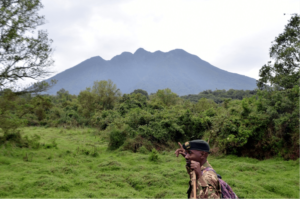 Mount Sabinyo Volcano Hike trips are organized from the Uganda side, one can hike up to its three peaks depending his/her physical ability, but a minimum journey to one peak takes about eight hours. In Uganda, Mount Sabinyo is located within Mgahinga Gorilla National Park in the southwestern corner of the country.
Mount Sabinyo Volcano Hike trips are organized from the Uganda side, one can hike up to its three peaks depending his/her physical ability, but a minimum journey to one peak takes about eight hours. In Uganda, Mount Sabinyo is located within Mgahinga Gorilla National Park in the southwestern corner of the country.
Due to the extremely rugged nature of the terrain along the Sabinyo’s slopes that has many craters with sharp ridges, the mountain cannot be trekked in the other two countries except in Uganda where they have managed to work out a safe though challenging trail that includes improvising handmade ladders to assist climbers at very steep sections.
Like all the other Virunga volcanoes such as Mount Gahinga Volcanoe, Muhabura Volcano, except the highest, Karisimbi Volcano Hike that requires 2 days, Mt. Sabinyo is a one day hike and the round trek is 8 hours, 4 hours to the summit and 4 hours back, however depending on the pace, weather, etc…
The journey of Mount Sabinyo Volcano Hike
Hiking activity of Mount Sabinyo Volcano Hike sets off from the park office after meeting with and briefing by the ranger guide.
Walking sticks are provided for free meanwhile the porters are available for hire between 15 $ – 25$. The trek takes you through vegetation ranges from the bamboo zone between 2400 – 2800m,
What to see during Mount Sabinyo Volcano Hike
Mt. Sabinyo Trekking Tour is an habitat for the Golden Monkeys which you are chanced at seeing on the way during the Climbing exercise.
Other big wildlife to see on Mount Sabyinyo a Volcano Hike include; Buffaloes, Elephants and Gorillas but are rarely seen on the trail.
Between 2800 – 3200m is a beautiful forest patch of Hagenia Hypericum, over 3200 is that Sub-alpine zone that has fewer trees. This is also territory of the famous Rwenzori Turaco, a stunning bird that is also endemic to the Albertine rift region.
At the summit you hike to each of the three summits and get the chance to be at the meeting point of all the countries, and enjoy the best views of all!
Items to pack for Mount Sabinyo Hike
-Long-sleeved shirt and trouser -Hiking Boots -Rain coat
-Stocking hat for warmth -Camera with Battery -Binocular
-Garden gloves for cold weather at the top
-Packed Lunch and snacks
Canoe Trekking - Lake Bunyonyi
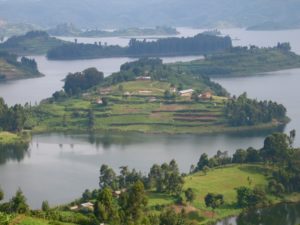 Lake Bunyonyi is located in southwestern Uganda. Lake Bunyonyi derives its name from the small birds that live in that area. This lake is the deepest in Uganda and is also stable throughout the year since it has got few waves. Lake Bunyonyi is the only one were you can ride a canoe to visit all the 29 islands on this lake including the floating Island and the punishment Island where the young girls who got pregnant before marriage would be dumped and left to die. Each of the islands on Lake Bunyonyi has its own history attached to it so you will have your 2-hour canoe ride with the best guide who will reward you with this history.
Lake Bunyonyi is located in southwestern Uganda. Lake Bunyonyi derives its name from the small birds that live in that area. This lake is the deepest in Uganda and is also stable throughout the year since it has got few waves. Lake Bunyonyi is the only one were you can ride a canoe to visit all the 29 islands on this lake including the floating Island and the punishment Island where the young girls who got pregnant before marriage would be dumped and left to die. Each of the islands on Lake Bunyonyi has its own history attached to it so you will have your 2-hour canoe ride with the best guide who will reward you with this history.
Canoe trekking trips on Lake Bunyonyi are a small-scale alternative to commercial tourism, for a traveller who wishes to treat the cultures and natural environment with special respect and learn something on the way. Edirisa’s interest is culturally sensitive economic development of remote communities that have few other opportunities.
Canoe treks on Bunyonyi are not as much about adventure tourism as they are about community /cultural travel. Hiking and paddling is a means to get to villages and areas that nobody else visits. Accommodation is tented but in many cases upgrades are possible.
THE MOUNTAIN GORILLA TREKKING EXPERIENCE
Mountain gorillas are wild animals and, as such, sightings cannot be guaranteed. However, for the last 14 years, no one has trekked the gorillas and failed to see them in Uganda. Certainly, you won't be the one with bad luck! On the trek, once you find the gorillas, you will be allowed an hour with the gorillas and you can only go not more than 6 meters from them. As the gorilla tracking can sometimes take a full day, you will need to go with your packed lunch and lots of drinking water when trekking to the gorillas.
Gorilla trekking timings and conditions vary tremendously as the gorillas move continuously through the rain forest. It is good to be prepared and remember the weather can change with very little warning. The terrain is often steep and through areas where there are no marked paths.
TIPS FOR THE BEST GORILLA TREKKING EXPERIENCE IN UGANDA
Secure Gorilla Trekking permits early
Gorilla Trekking is the most popular foreign tourist activity for Uganda. On every single day, only 128 tourists can trek the gorillas in Bwindi. Uganda has the cheapest gorilla permits prices at USD600 (or USD700 beginning July 2020) for safe gorilla tracking as Rwanda's gorilla permits cost USD1500. This means the competition is quite high for the few gorilla permits in Uganda and it becomes hard to secure gorilla trekking permits a few days to your Uganda gorilla tour (although it is often possible with luck more so in the green season months of October, November, April and May). It is best to have your gorilla trek permit fully confirmed at least 4 months in advance.
Assess your fitness levels
There is a likelihood you could walk for 3-6 hours on a gorilla trek. Gorillas are located deep in Bwindi forest with thick undergrowth over several steep volcanic slopes. Gorilla groups keep roaming this forest looking for their favorite food. They are never stationed in the same place over days. Your gorilla trek will follow this same trend and it is quite unpredictable knowing how long or tough your gorilla trekking shall be. The longer trek is not necessarily a problem, just something to be prepared for. A bit of moderate physical fitness is needed for gorilla trekking in Uganda.
Guides & Porters for the gorilla trek
You will be guided through the forest on your gorilla tracking by a Uganda Wildlife Authority guide whom you will meet at the departure point in the morning of your trek. Your guide can help you book a porter (or two!) so that you can track without having to carry the few essential items listed below in a day pack which you should bring with you. The porters are from the local community and very used to the local conditions and can assist in pushing, pulling and supporting you during your trek to the gorillas. They are usually an additional fee, over and above your safari cost, and you should budget on approximately USD15-20 per porter per day as a fee with additional tipping being optional.
As the porters do not have tracking permits they will be stopped a short distance from the point you will be viewing the mountain Gorillas. Please remember to take whatever you may need from your bag to view the gorillas and rather leave valuables at the lodge/camp.
You will be allowed up to one hour for viewing of the gorillas from when they are sighted by your group. This is to ensure that the wild animals are not overexposed to human presence. Whilst in their presence you will also be required to keep minimum distances from them – generally between 5-7 metres and your guides will ensure this is enforced.
What to pack on gorilla trekking
• Plenty of water – 1-2 litres per person
• High energy snacks in addition to your packed lunch provided by the lodge/camp
• Spare film and batteries for videos and cameras
• Gloves (gardening type are good)
• Waterproof bag to protect photographic equipment
• A hat, sunscreen, mosquito repellent and band-aids might be useful
• A lightweight waterproof jacket/poncho
• Walking sticks are made available at the start of the trek for some of the steeper and more slippery tracks and may prove to be very handy.
Gorilla Trekking Age Limits
The age limit for gorilla trekking is 15 years and the authorities are very strict on this! With special written permission however, a 14yr old might pass.
Videos & Photography for Gorilla Trekking in Uganda
In Uganda, it can be difficult to capture good photos under the dark canopy of Bwindi Impenetrable Forest, as the name suggests! If you are very lucky, you may encounter your gorilla family in a clearing.
Here are a few tips for photographing the gorillas in Uganda:
- If you’re taking photos using a standard point-and-shoot camera, then make sure your camera is fully charged.
- Always take extra memory cards.
- Remember that flash photography is not allowed when you are with the gorillas. Make sure you have your camera manual with you so you know how to disable the automatic flash and automatic focus light functions.
- We recommend a good SLR camera. The best lenses are those with a wide aperture such as f2,8 which allow in max light and are best in gloomy conditions. A 24 – 70 mm and a 70 – 200 m is a good combination. If you have space then consider a 300mm and a wide angle but it’s a steep walk so consider hiring a porter. A 50 mm 1.4 lens is also ideal for low light shooting and something to consider as a standard lens.
- Professional filmmakers require permission and need to purchase filming permits in advance from UWA (Uganda) or RDB (Rwanda).
- Keep your camera and/or phone in a waterproof bag (such as a large Ziploc bag). Cue: you’re in the rainforest.
Professional photographers, film makers or media should advise us at the time of booking as special procedures are required as well as costs to be incurred for photographing and filming.
CAMERA SETTINGS FOR GORILLA PHOTOGRAPHY
File format
Shooting in RAW format is the way to go. A jpeg is smaller in size because it discards a lot of information and so information cannot be retrieved if your exposure is slightly out. If you are shooting in jpeg, make sure your camera is set to the largest file size and also set your white balance according to the light conditions.
ISO and shutter speed
It can get dark in the forest – very dark. And gorillas are very dark subjects. If you have a Nikon D3x or D800 you can shoot at ISO 3200 and get away with it very well. My recommendation however is to try to keep in the range of IS0 800 to 2000 for maximum quality of image. High ISO gives a faster shutter speed but can affect quality and cause noise. Keep ISO as low as possible without getting blurred images. A rule of thumb is don’t shoot below 1/200th of a second with a 200mm lens. If you are using an 80 mm lens then you can shoot at slower speeds of say 1/80th and so on. If the gorillas are on the move you should up your shutter speed to 1/1000th of a second or more.
Metering and priority settings
A good default setting is to use centre weighted metering, aperture priority and an aperture of f5.6 or so. If there is a lot of dark gorilla in the viewfinder you will need to underexpose by up to two stops of light – 2 using your AE +/- button or you will overexpose your image. It is also a good idea to consider manual shooting if you are in fairly consistent lighting conditions. Your camera likes shooting subjects where the differences in exposure are not too extreme and its for this reason that cloudy or shady conditions are often best for shooting dark subjects like gorillas.
Focus
Single point focus is usually always best – you don’t want the camera focusing on the tree instead of the gorilla and usually you will want to lock your focus on the eyes. If you have a group of gorillas that you want to keep as much in focus as possible then focus about 1/3 into the picture. You may want to change focus to multi -point if you have lots of moving subjects but suggest single focus points will give you more control. You will probably shoot on single shot, but may want to change your focus settings to continuous focus and rapid fire if they are on the move and playful.
SHOOTING TIPS
When you are with the gorillas there is a 7 meter buffer rule between you and animals. The reason is that their DNA is so close to ours that it is very easy for them to pick up flu and colds. Gorillas don’t know this rule and so don’t be surprised if they do approach closer (and be ready for it with a wide lens available), but if the guides ask you to move away then always do so smartly.
Your time with the gorillas is precious. Don’t shoot away wildly. Plan your shots. Close ups, wide shots, angles and framing. Think about your options. Also don’t forget the wide shots of Make sure that you don’t spend the whole time looking through the lens. Sit and watch and consider the fact that you are watching one of the gentlest and most fascinating creatures on the planet.
As with all wildlife photography it’s about the moment. Try to catch the little moments such as when the gorillas are interacting or when the sun catches their eyes. Also why not video your friends as soon as its over and let them tell you about their experiences of this fantastic experience.

